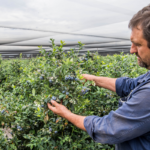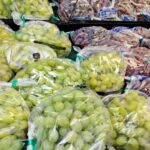Q&A: Berry chat with Driscoll's of the Americas president Soren Bjorn

The berry industry worldwide has undergone whirlwind changes for both growers and consumers alike, and U.S.-based multinational Driscoll's has altered the way it does business in the process. During the Produce Marketing Association (PMA) Fresh Summit convention last month, our editor Matt Ogg sat down with the company's president for the Americas, Soren Bjorn, to discuss trends across the four main berry categories, labor challenges, key growth areas and much more.
Before we get started, is there anything in particular you'd like to highlight from Driscoll's at the moment?
Internally in the company our big growth areas are a little bit different to our historical growth. We have mostly been a strawberry and raspberry company in the past, but our really rapid expansion is happening in blueberries and blackberries; those two berries are growing much faster than the other two.
With that we’re actually ending up with a truly blended mix of the four berries compared to the past, and then organics is growing much faster than conventional; it’s probably growing three times faster than conventional.
Today it’s about 20% of our business but if we could have our way it would be a third of our business.
A couple of years ago we talked about the company's move into organic nurseries, even though this initiative is not required in order to achieve organic certification. How has that developed since then?
It’s been very successful. We talked about it back then that it’s a very long process to do that conversion, but we are continuing every year and we’ve got more and more acres and we really haven’t run into any issues. We are still on track to having 100% organic plants for our organic fruit production. We just think that helps bring more integrity to the system; it makes it less likely that the industry gets criticized for what we’re doing.
Even though it wasn’t something you could do before, we think it’s the right thing to do.
In the past we've also spoken about raspberries as a crop where improvements are needed. While blueberries and blackberries seem to be the focus, how about the search to find raspberries that hold up well during shipping and have better flavor?
I think it’s interesting for us. Some of the other berries like blackberries have gotten so much better, and that probably highlights the opportunity we have in raspberries to make those better tasting.
We made a lot of progress on shelf life and appearance in raspberries – they’re no longer dull and dark and soft; they’re bright red and shiny with at least decent shelf life. But our big opportunity in raspberries still is to dramatically improve the flavor, and we know we can do this. But any time with genetic development, it’s not quick. We’re going to have to be patient.
And do you think the future of that and other berries will be in substrate production?
I don’t think there’s any doubt about that, especially as you have challenges for labor availability and labor cost. We have to go to labor production systems that are more efficient and also more efficient for the harvesters so it's easier for the fruit to be picked.
Something like a raspberry crop is very labor intensive. It can get very pushy and crowded once you’re on the first cycle, so one of the opportunities is to grow them in substrate and spread the plants out. It really helps with the ease of harvest and the ease of production, so that is very much the journey we’re on.
But it’s happening. In Europe it’s a big part of production and in Australia we are 100% already; in Tasmania on strawberries it’s 100% tabletop strawberry production because it’s easier for the harvesters and in many ways it’s easier for the grower once you get it set up. There’s a big upfront investment, but in the long run it’s not a big investment. Once you get over that, then actually there’s a lot less work.
Would you say it's the same in blueberries?
It’s the same in blueberries, but in blueberries what’s happened is when you go to substrate you actually get fruit production much faster and that’s the real big payback. The disadvantage of blueberries compared to other berries is it’s slow, but in substrate you can actually make it a lot faster.
And it’s also opened up regions where maybe the climate is right but the soil is very difficult, because blueberries are very temperamental. They need that low pH, and if that doesn’t naturally exist and the soil is heavy, it’s difficult to manage. If you go to substrate, you can get that right away.
It's timely that you mention that. I was speaking with people from the Guatemalan delegation today and it seems like they’re going to be doing a lot of production with pots under protective tunnels. Is Driscoll’s involved there at all?
We haven’t gone to Guatemala. We don’t feel like we need it to get year-round production on the berries that we have. But I think for an industry like that it does make sense – it makes it more reliable. Our customers want it to be more reliable than it’s been historically.
I think you see that everywhere. In China as you know we’re fairly new. We're starting in the advanced production system. So even though the cost in China is lower, we are spending all the money on the very expensive production systems because we know that’s where we’re going to go eventually.
So instead of waiting you're going down that route from day one. And perhaps that’s also relevant in light of the growing middle class in China and the fact one day their industry might struggle to find farm labor. Is that a concern?
Sure. Availability of farmworkers is a worldwide issue for us. We grow in 22 countries and there is not one country where this is not an issue. We have a shortage everywhere.
Now, some places have better solutions than other places, but even in Mexico today we don’t have enough workers for the fields. But there are more solutions in Mexico than say the U.S., but the problem is that in the U.S. the solutions aren’t very good right now. That of course is very political.
At an organic panel discussion yesterday there was mention of how the legalization of cannabis in California could bring farmworkers over to that industry. Is that something you're considering?
Well, we’re not planning to get into cannabis production.
But what do you think could be the impact?
Certainly the labor availability issue is a huge issue, whether that is in immigration reform or not, with the general flow across the border between the U.S. and Mexico, and the attractiveness of other work like cannabis production which happens right next to where the berry production is.
Most of the glasshouses in California that were available got bought out by cannabis growers at 10 times the price of what those glasshouses were going for six months earlier, so there were all these glasshouses that were used for flower production that are now being used for cannabis production.
It’s not as labor-intensive a business as our business, and even if it’s a huge business it's not nearly the scale that for example a berry business is, which is tens of thousands of acres. So hopefully people aren’t going to smoke as much marijuana as they eat strawberries.
That [legalization] would put additional pressure but that just puts more emphasis on us to find solutions. We have to make the work of harvesting berries easier for the worker. It has to be easier for the worker than it’s been historically to do the job, and they can make a better living than they have historically.
And that also ties in with the tabletop production and harvesting trend.
It may not be all of it. In the U.K. when I first went there 11 years ago maybe 5% of the business was in tabletops for strawberries. Today it’s 65%. So it’s still not 100% 10 years later, but of course that change dramatically eased our demand on labor.
It’ll be a combination of things – hopefully a new guest worker program that’s easier to administer. There will be new technology that attracts a different demographic of people into doing the work.
And then there’s the workforce that’s there today that’s diminishing, but it’ll still be there. It’ll be a combination of those three things.
Of course we don’t have control over the new guest worker program but even if we have to work with the current program, as much as we don’t like it we will make that work. Historically we probably wouldn’t have found ourselves in the farmworker housing business but that’s probably unavoidable going forward.
Moving on to households, let's talk about the demand side of the equation. In the State of the Industry yesterday PMA president Cathy Burns said while there was so much conversation online about food, there was very little interaction between consumers and food companies in the digital world.
It seems as if the #BerryTogether branding you’ve done at Driscoll’s is an attempt to get more interaction. How has that conversation been improving?
One of the things I think Driscoll’s has historically done a good job of is listening to consumers. We are a brand developed on consumer traits – flavor, appearance and the condition of the berries. So we built a company that way and we continue building the brand, and we created this online consumer panel where we get feedback from 500,000-600,000 consumers a year, which is an unbelievable amount of people.
It’s really out of that in our ability to have this dialogue with consumers online that really let us believe that we could actually create a much close connection with the brand and consumers.
We did this trial campaign in Minneapolis and recorded it on YouTube, and we had more than five million people see that YouTube video. It just goes to show that people are very passionate about food; not all food, but certainly some food products. And it turns out people are very passionate about berries.
It doesn't matter whether they are China or in Europe or in Australia or in North America, consumers have an opinion about berries and they are more than happy to share it. For us that’s a tremendous opportunity.
I think what’s happening is a lot of companies have picked up on that. Look at grapes for example – grapes are doing the same thing today. They’re much more focused on flavor – they used to have a couple of varieties of reds and a couple of varieties of greens and that was sort of it. Nowadays there are dozens of varieties.
In large part they’re copying what we have done already and good for them, because I don't think there’s any magic around that consumers want their food to taste good, and if you have something that tastes good they will eat more.
But the difference is you’re marketing the Driscoll’s brand rather than individual blueberry, raspberry, strawberry or blackberry brands.
Sure. Whereas we go about it in different ways, I think you’re going to see more people attempt to do what we have done and do it with a brand because there’s a lot of power in that. Every time you’ve got a new variety you’re not starting out all over again in your marketing. So maybe the varieties become more sub-branding as opposed to the primary branding.
Today it’s the other way around – the varieties are the primary and the growers and the shippers are the sub-brand. I think the big players are going to want to do it more the way we’ve done it. It’s not easy and you need a bigger marketing budget than what you used to, but if you want to get close to consumers that has to be part of the equation.
Do you have any figures on hand that demonstrate how your sales have increased for particular berries?
I can tell you for example that in our blackberry business, if you take some of our top customers – the top three or four and maybe some of the smaller ones where we’ve had a special effort – their year-over-year growth is not 10 or 15%. It’s 50-60% year-over-year growth in blackberries.
And they will all tell us that it’s all driven by the consumer experience; this isn’t just that we just have more supply to give them, but the product is fundamentally different. And consumers are telling them that it tastes a lot better.
That’s the sort of sleeper category we’re in with berries; it’s been growing very slowly and now for us it’s really taking off. I think that goes to demonstrate the type of business you can get.
Similarly on blueberries, for part of our blueberry program out of Mexico the kind of price premium we’re getting over the general blueberry market for part of the season, it isn’t 5-10%; it’s 30-50%, because the product is that much better.
That's surprising in the context of the dramatic increases in supply from Peru this past season.
I think there was this mentality in the blueberry business that blueberries were really a true commodity, and we kept arguing that it wasn’t.
I have personally been in conversations with customers where they say, "no, you can’t really differentiate in blueberries." Now, I was just at a meeting about a month ago in New York, where a customer told me, "I told your CEO that he was wasting Driscoll’s’ money in genetics, and I was wrong – I now realize that it actually was possible."
We always believed it was possible, but one thing is to believe and another is to make it happen. It’s not that we want to sell at a 50% premium - we don’t want to be that far away from the market - but when we come out with something that’s that good, it’s possible.
And that can happen in other categories as well. The other thing you’re seeing with some of these new apples that are coming out, they’re not retailing for US$1.49 a pound; some of them are retailing for US$3.49 a pound. And it’s all driven by the quality of the product – as an industry we still need to be really focused on the consumer, and all the companies here that are not focused on consumers need to be.
That brings me to another point I was wanting to discuss. You discussed production methods in China – what about getting that same level of consumer engagement there? What have been some of the early signs?
One of the early surprises for us is that probably the highest price we have worldwide is in China.
Is that in blueberries?
It's blueberries grown in China of high quality grown out of the joint venture (with Costa Group), and we sell those for more than we sell blueberries anywhere in the world. Now, the product is great, but for the upper share market you need to have the right quality. If you speak to the cherry people in Chile and California and the Pacific Northwest, they send their very best product to China and they get phenomenal prices.
That’s the tier of the market. In the long-run, our ambition goes beyond that but trying to start a business up that's the margin that's there if you focus on the right quality.
Sometimes what worries us is that you might have imported product that’s been on the boat for 40 days, and by the time it arrives it’s pretty marginal. And that’s not a good way to build the business in China because it’s going to turn the high-end consumer off.
You really need them on board – once you can lower your price because you’ve got yourself established and you’ve got a cost structure in place and you want to go to the next tier of the market which is much bigger, now you’ve got to have a better price but you better have the same quality or else you’re going to lose the loyal consumers you already have.
Another learning is that especially our local team in China was worried about raspberries, because Chinese consumers don’t know what a raspberry is. Ironically you see it on billboards in China for ice cream commercials, even though the consumers will tell you they don’t actually know what it is.
But again, when you have a relatively limited offer and you’re directing it at a pretty narrow audience, it turned out that even though we have grown the business a lot and we continue to grow it a lot, price hasn’t suffered a lot. And our local team didn’t think that would be possible.
Our experience in China was a little bit like our experience in Australia – completely different market, but the same thing happened in Australia with raspberries; we still haven’t seen a decline in price, even though the business is 10 times bigger than when we started 10 years ago.
Yes, I’ve noticed. I was in Australia recently visiting family and was considering buying some, but they were something like AUD$7-8 (US$5.36-6.13) for a punnet!
We never thought that was what was going to happen. We definitely thought we would see some degradation in price over time, and to some extent we would have been okay with that because the market would expand. But those are some of the surprises.
But China is hard – I don’t want to make it so that it sounds like it’s really simple. The logistics are complicated, we have been very fortunate to recruit an incredibly talented team that really love our business, and they love the fact we bring them to the U.S. and get them to understand our culture and business from the inside.
So for them it’s been a really incredible experience. We’ve got a really creative marketing team, really creative product innovation. Our local team there is just so enthusiastic about what we’re doing, and we’ve also got great support from local government, and so I think we have done a lot of the things you need to do in China.
We have enough patience to do it the right way, but the addition of our joint venture partners Costa in China is also helpful because we can get some things going much faster rather than just trying to do it ourselves. It’s still early days but I’m very impressed with the trend there.
Looking further afield in Asia, the U.S. blueberries have access to India, it has just been granted for Chile, and Peru isn't far behind. Is India now in Driscoll's sights?
It’s far away from the U.S. so as an export business it’s still at the edge of how far you can take things. The biggest issue in India today as we’ve looked at it I really the supply chain. The supply chain in China is complicated, but it’s better than India.
And our products, given they’re so perishable, need a really good supply chain and we just think today it’s a bridge too far.
That doesn’t mean it will remain that way, and you can undoubtedly grow there because you’ve got a lot of elevation to play with in the northern part, and I’m sure one day we’ll be there. But for us right now we just have a few other priorities.
I'm sure you have a lot of people to speak with here, so thanks for covering such a broad range of topics as usual.
Any time.












































